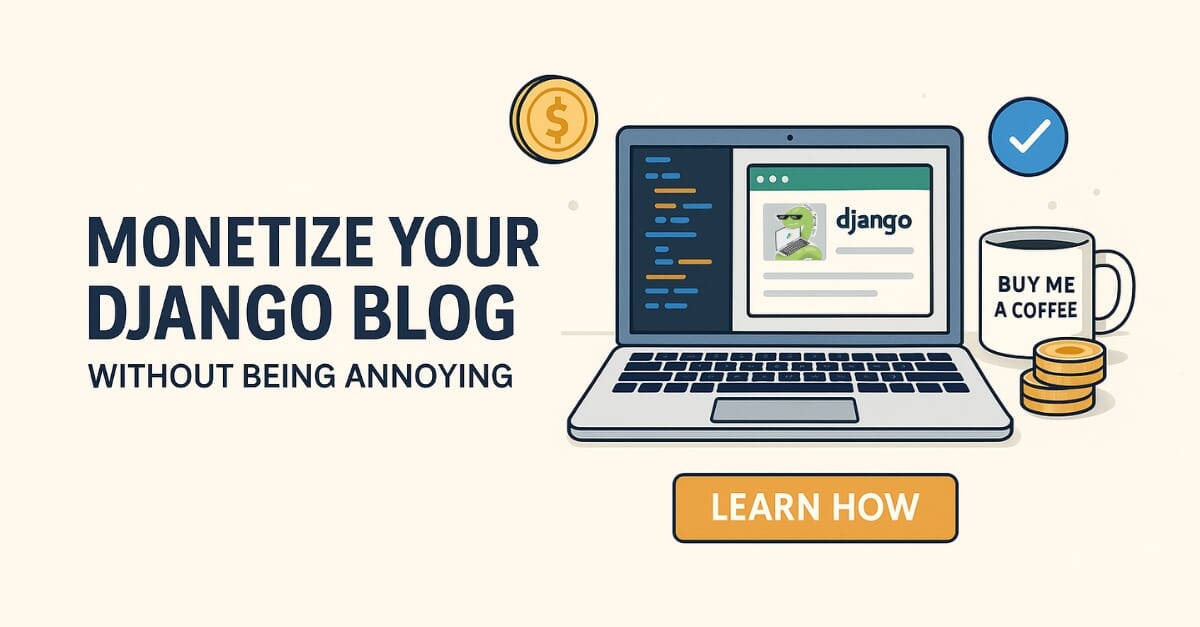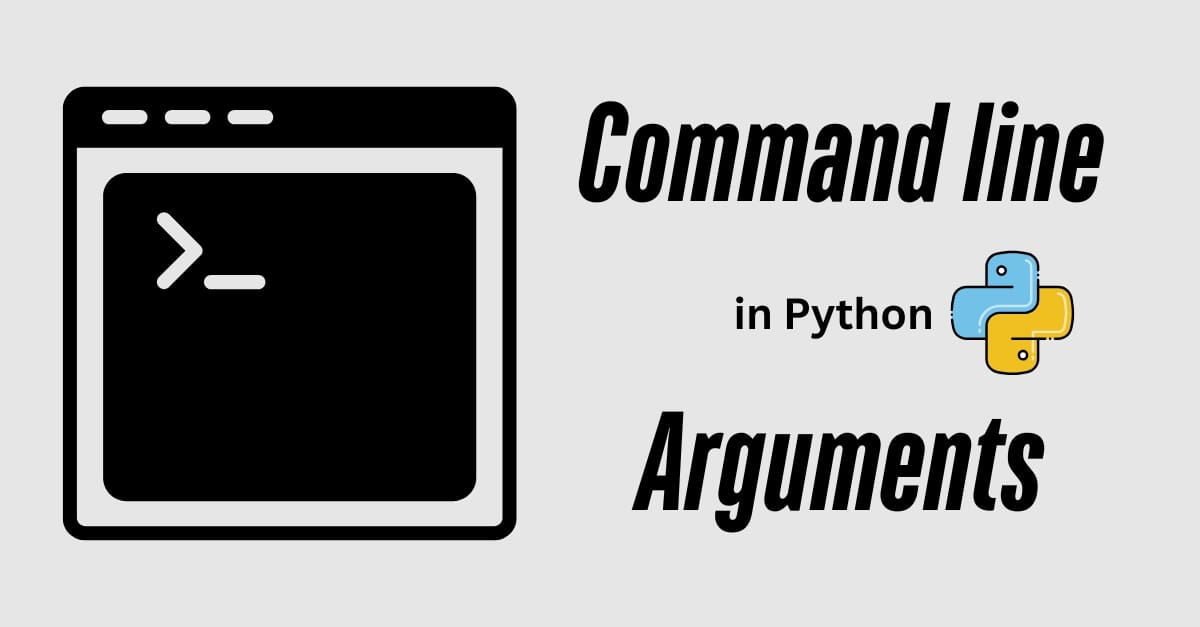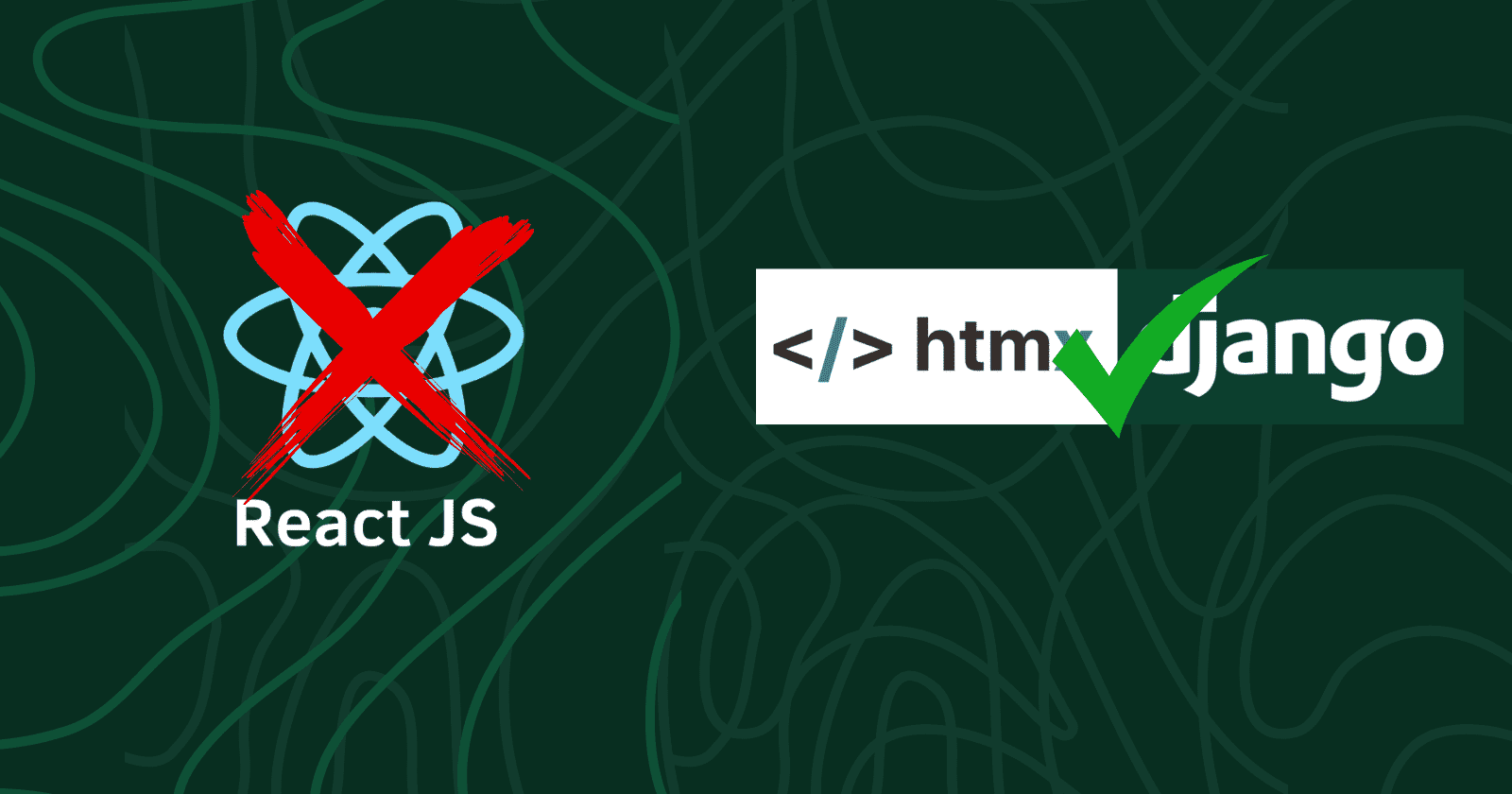Many developers consider monetizing a blog or tutorial website at some point, particularly if it was created using Django. After all, you should be compensated for the time and effort you invest in producing high-quality content. However, it can be difficult to accomplish this without making your website a distracting mess of popups, advertisements, and other distractions that drive users away. The good news? It's not necessary to compromise user experience or your own development values in order to monetize a Django blog.
In this article, I’ll walk you through ethical, developer-friendly, and scalable ways to start earning from your Django site. Whether you’re just getting started or have been running your blog for a while, these approaches can help you generate income while maintaining a clean, enjoyable experience for your readers. It’s all about finding the right balance — offering value to your audience without interrupting their learning journey or cluttering your site with invasive ads.
I am the owner of django-tutorial.dev, a website devoted to assisting developers in efficiently learning Django. I've tried a number of monetization strategies over the years that honor the developer culture and the user experience. Some of those lessons and tactics are discussed in this article to help you make decisions that are appropriate for your project and objectives. Making money from a Django blog or tutorial website is a process rather than a quick fix. It calls for careful preparation as well as occasionally some trial and error. However, with the correct strategy, it can be a fulfilling way to fund your work, devote more time to content production, and expand your website in a sustainable manner. Therefore, you're in the right place if you've been wondering how to make money off of your Django project without upsetting your users or jeopardizing the integrity of your website. Let's look at doable, civil ways to help you start making money from your Django tutorial website or blog while maintaining the satisfaction and interest of your readers.
8 Developer-Friendly Ways to Monetize (including a hidden Gem)
-
Use Affiliate Links
Affiliate links are one of the easiest and most accessible ways to start creating money through your Django blog or tutorial website if you're just getting started. The concept is easy: you recommend goods or services that you actually find helpful or enjoyable, and you receive a small commission when readers buy a thing using your unique affiliate link.
For example, many developers like to use tools that make coding easier or read books that teach them more. Amazon's affiliate program is perfect for this. You can recommend popular Django or Python books, coding equipment like keyboards and headphones, or even gadgets you use at work. Your readers feel at ease using your links to make purchases because Amazon is a trustworthy website.
Affiliate programs are offered by hosting companies such as DigitalOcean and Linode in addition to Amazon. Sharing these links is a natural fit for your content because many developers require dependable and reasonably priced hosting for their Django projects. You receive payment when someone registers using your link, and your readers benefit from a reliable hosting choice.
SaaS tools related to Django are another excellent affiliate marketing niche. Developer-focused affiliate programs are available for many services, including code editors, deployment tools, and debugging platforms. Since these tools directly address the needs of your audience, recommending them can benefit both parties.
Tip: Use a Markdown rendering library or the built-in flatpages app in Django to make adding affiliate links easy. With the help of these tools, you can quickly add affiliate content to blog entries or pages on your website without clogging up your templates or views. It makes it easier to update affiliate links when necessary by maintaining a clean workflow and well-organized content
Affiliate marketing done right means providing genuine value and helpful recommendations while earning some extra income along the way.. -
Offer Paid Downloads or Templates
Offering paid downloads is a fantastic way to make money off of your Django tutorial website or blog. These could be project templates, PDF cheat sheets, or even helpful code snippets that help your readers save time and effort. Packaging your hours-long creations of resources that can help others accelerate their development as downloadable products allows you to share your knowledge and earn money at the same time.
A well-organized Django project template, for instance, can be a lifesaver for novices or time-pressed developers seeking a reliable foundation. Because they are convenient to refer to during coding sessions, cheat sheets that condense difficult ideas, commands, or workflows are also widely used. Mini libraries or bits of code that address common issues can also be very beneficial.
It's simple to integrate PayPal or Stripe into your Django website for payment processing. Both make it easy for your users to make secure payments by providing strong APIs and support for one-time payments. You might want to look into packages like django-payments or dj-stripe if you want to manage payments in Django with ease. These tools save you from having to start from scratch when managing transactions, webhooks, and order confirmations.
Tip: Lock your downloads behind user authentication and payment confirmation to safeguard your content and guarantee that only paying customers can access it. This implies that before users can download any files, they must log in and finish their payment. This can be done by integrating your payment flow with Django's integrated authentication system, making the entire process seem smooth and expert.
By offering paid downloads or templates, you create another revenue stream that respects your users’ time and adds real value to their Django learning journey. -
Launch a Paid Course or eBook
You most likely have a wealth of content that your audience enjoys if you've been blogging or making tutorials for a while. Making your best-selling blog series into a downloadable eBook or introducing a premium paid course are two great ways to make money off of that. This method gives you a strong product to sell and enables you to package your knowledge in a more organized, polished format that is simple for students to follow.
The approach of converting blog entries into eBooks is surprisingly simple. You can compile relevant articles, refine the formatting, include more examples or advice, and make it available as a PDF or EPUB file for download. Many readers value having everything in one location, particularly when it's aesthetically pleasing and well-structured.
Django provides a wide range of adaptable methods for creating and delivering content for courses. Tools like Wagtail or Django CMS can assist you in organizing lessons, tests, and user progress without having to start from scratch if you're looking for a feature-rich content management system. If you prefer something more straightforward, you can use Django views and templates to create a simple flow with videos, tests, and certificates. Offering premium content while maintaining platform control can be accomplished in this way.
Tip: Use "unlisted" settings on websites like Vimeo or YouTube to keep your course videos private and secure. After that, make sure the videos are only accessible by paying users by serving them through your Django app. This gives your students a seamless viewing experience while safeguarding your content from unrestricted sharing.
Launching paid courses or eBooks lets you turn your hard work into a sustainable income stream, while also delivering real value to your learners in a professional, scalable way. -
Accept Donations (If You’re Helping the Community)
Accepting donations can be an easy and considerate way to make money off of your Django blog or tutorial site if it offers the developer community real value. Sometimes, your readers don't want paywalls or complicated transactions; they just want to say "thank you" and support your efforts.
If your audience finds your content useful, it's simple to allow them to contribute by adding a "Buy Me a Coffee" button or a Stripe donation option. This approach is particularly effective if you want to maintain your content's free nature while still having a means of obtaining funding. It puts little strain on your readers, but if you develop a devoted following, it can add up over time.
Donations are essential to the operation of many large projects and communities. For example, Mozilla, the company that creates Firefox, uses donation campaigns to finance their open-source projects. In order to continue their work, DjangoGirls, which hosts free workshops to teach women Django, also takes donations. These well-known instances demonstrate the impact and significance of donations for neighborhood-based initiatives.
Tip: Make a CSRF-protected POST form that initiates the Stripe checkout in order to securely add a Stripe donation button to your Django website. This method keeps your website safe and allows users to easily support you without ever leaving your page. You can quickly set this up with the help of Django packages and a wealth of tutorials.Accepting donations is a humble but powerful way to connect with your community and earn support while keeping your content accessible and free for everyone
-
Offer Freelance Services or Consultations
Offering freelance services or consultations can be a very successful way to make money off of your skills if your Django blog or tutorial site has established a solid reputation. Numerous readers who value your work may want to hire you for one-on-one mentoring, code reviews, or custom Django projects. These opportunities may become available to you if you have a clear "Hire Me" page on your website.
A "Hire Me" page only needs to provide a brief overview of your services, areas of expertise, and contact information for potential clients. Use Django's built-in forms to gather questions or requests for appointments to streamline the process. This keeps things organized and gives you all the information you require up front.
You have two choices for setting up meetings or consultations. Third-party tools like Calendly, which manage reservations, reminders, and calendar syncing without the need for additional coding, can be directly embedded on your website. If you don't want to build your own system, this is easy to set up and effective.
You can create your own scheduler with Django forms and a model that tracks your availability if you'd rather have a customized solution. This method integrates seamlessly with your current Django app and offers you complete control over appointment management. It can be tailored to precisely match your workflow.
Tip: Whichever method you choose, keep the user experience seamless and professional. Clear communication and easy scheduling go a long way in turning visitors into paying clients.Offering freelance services or consultations not only monetizes your skills but also deepens your relationship with your community and helps you grow as a developer
-
Build a Newsletter, Then Sell Ad Space
Building a newsletter is one of the most effective ways to make money from your Django blog or tutorial website. Using an email list enables you to communicate with your audience directly, distribute your most recent announcements, advice, and content, and cultivate a devoted developer community that respects your knowledge.
To begin, packages like django-anymail make it simple to integrate Django with email marketing platforms like Mailchimp. With your Django site serving as the focal point, you can use this to automate campaigns, manage your subscribers, and create polished emails. Although it might take some time to grow your email list, there are exciting monetization opportunities once you have a sizable number of active subscribers.
You can begin including ad slots in your emails once your newsletter has reached 1,000 or more developers. Numerous businesses seek to connect with specific audiences, such as Django developers, and your newsletter can serve as an effective platform for promoting pertinent goods, resources, or occasions. By selling ad space in your newsletter, you can make money without overcrowding your blog and giving your readers a clean experience.
Tip: It is simpler to track email performance and sync subscriber data directly from your Django admin when you use django-anymail for Mailchimp integration. This enables you to determine the most effective content and optimize your campaigns to continue expanding your influence and list.Building a newsletter is a long-term strategy, but it’s a win-win: you nurture a community hungry for your content while creating a scalable, respectful revenue stream through carefully chosen sponsors or advertisers.
-
Sponsored Posts and Partnerships
Sponsored posts and partnerships present another avenue for revenue generation as your Django blog or tutorial site becomes more popular. This implies that businesses or services that cater to your readership pay you to write articles that highlight their goods or equipment. As long as you are open and truthful with your readers, sponsored content can be a fantastic way to make money while offering helpful information.
Here, transparency is essential. Always indicate which posts are sponsored, either by including a brief disclosure or by adding a label at the top of the article. Your honesty will be valued by your readers and contribute to the preservation of trust, both of which are necessary for sustained success. In order to avoid giving your audience the impression that they are being sold to, sponsored posts should still be valuable and organically align with your content.
Consider creating a sponsorship dashboard within your Django admin to effectively manage sponsored content, or use Wagtail's robust interface if you're using a CMS to keep tabs on sponsors, post status, and payments. You can schedule posts, stay organized, and interact with sponsors without having to switch between tools thanks to this.
Companies are exposed to a specific developer audience through sponsored posts, and you are compensated for producing content that is relevant to the theme of your website. Just be sure to maintain high editorial standards and only collaborate with partners who share your brand and the interests of your readers.
Tip: A sponsorship dashboard can automate reminders for upcoming sponsored posts and even track revenue, giving you clear insights into your monetization efforts—all managed within your familiar Django environment. -
Ad Networks (The Classic Way)
Ad networks are frequently the first thing that spring to mind when considering ways to make money off of a Django blog or tutorial website. They're a traditional, uncomplicated method of generating passive income by showing your visitors advertisements. The most well-known is Google AdSense, which is simple to set up and can begin making money right away. AdSense shows your audience relevant ads when you add a little JavaScript code to your Django templates.
However, not every ad network is made equal. Traditional advertisements are considered disruptive by many developers and users; popups, gaudy banners, and autoplay videos can detract from the user experience and even drive away visitors. For this reason, networks of ethical ads such as EthicalAds and Carbon Ads have gained popularity. They emphasize showing a few, quiet ads.
Ad networks are easy to set up in Django. To ensure that ads show up consistently on all of your pages, you usually add the ad network's <script> tags to your base.html or main template file. Accurately tracking impressions and clicks is also crucial, and some networks handle this automatically. You can use this information to better understand the effectiveness of your advertisements and adjust placement over time.
Important: Always place ad scripts thoughtfully to maintain a clean, distraction-free site layout. You want ads to support your monetization goals without compromising the experience that keeps visitors coming back.Using ad networks can be a reliable income stream, especially as your traffic grows. Just choose networks that align with your values and audience expectations to keep your site developer-friendly and enjoyable.
-
Coding Problems Challenges (Hidden Gem)
Creating a system that allows users to solve Django-related coding problems directly on your platform is a lesser-known but effective way to make money off of your Django website. You develop an interactive learning environment that keeps your community interested and returning for more, as opposed to merely providing static tutorials or downloads.
There are several inventive ways to make money with this setup. For instance, charge admission to coding contests that offer cash or merchandise rewards. Users are encouraged to participate by the excitement and friendly competition this creates. To provide serious learners with access to more challenging or exclusive content, you could also offer premium challenges or "unlockable" problem sets behind a paywall.
Giving out badges or certificates to users who finish tasks or hit milestones is another clever concept. These can be displayed on LinkedIn or user profiles, appealing to developers' need for validation and evidence of their abilities. It's a fantastic way to contribute in ways beyond education.
Technically, building a leaderboard, automated code testing, and a challenge submission system is simple thanks to Django's forms and models. You can create a process that allows users to submit solutions, receive prompt feedback, and see how they stack up against other users. This gamifies education, transforming it from a passive process into one that is enjoyable and social.
Your site can grow naturally through developer communities and word-of-mouth because interactive challenges are more engaging than regular blog posts or courses. It's a distinctive product that makes you stand out, fosters customer loyalty, and creates new revenue streams.
This interactive, gamified strategy is undoubtedly a hidden gem worth investigating if you want to stand out and create a vibrant community.
Conclusion
It doesn't have to be difficult or invasive to monetize your Django blog or tutorial website. There are numerous developer-friendly, ethical ways to begin making money, ranging from simple approaches like adding affiliate links or taking donations to more complex ones like starting paid courses or collaborating with sponsors.
My recommendation? Start slowly. Consider including a "Buy Me a Coffee" button or strategically placing affiliate links for Django tools, books, or hosting. By following these easy steps, you can start making money without affecting how users interact with your website. You can scale up with sponsored posts, premium courses, or even interactive coding challenges to engage your community once you feel more at ease and have a better understanding of your audience.
Many of these tactics are being tested by me on my own website, django-tutorial.dev, and I've discovered that the process is rewarding and sustainable when monetization and developer respect are balanced. It all comes down to providing genuine value first, then looking for innovative ways to profit from it.
I would love to know how you make money from your work or what ideas you plan to try if you are currently managing a Django project or are considering starting one. This community thrives when we all learn and develop together, so please feel free to leave a comment below or share your experiences.
Remember, monetization is a process rather than a race. You can maintain your reader's satisfaction and engagement while transforming your love of Django into a viable side business or even a full-time job with careful execution







No comments yet. Be the first to comment!